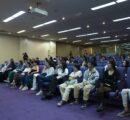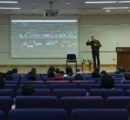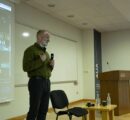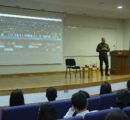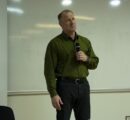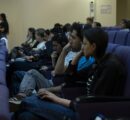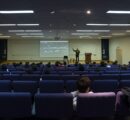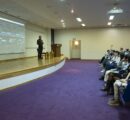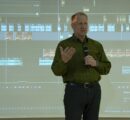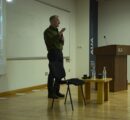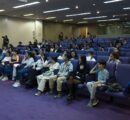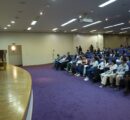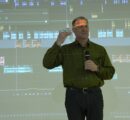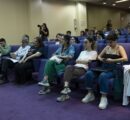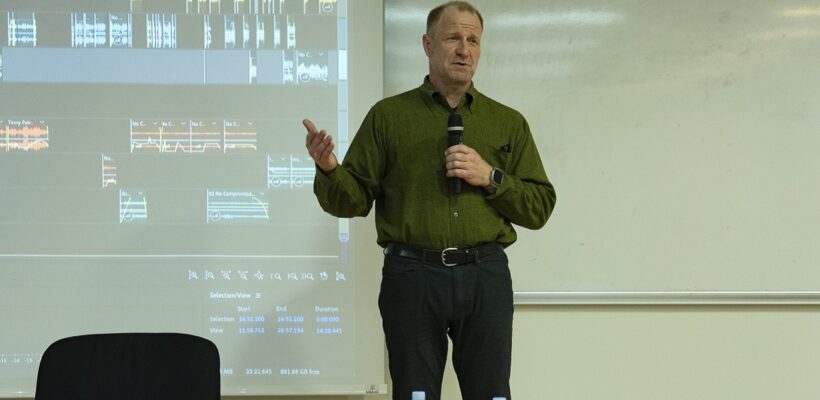
Pulitzer Prize-Winning Journalist Hosts Masterclass at AUA
4 min readYEREVAN, Armenia — On April 5, the American University of Armenia (AUA) hosted Pulitzer Prize-winning journalist Graham Smith for a masterclass titled “The Audio Art of Truth Discovery” in Manoogian Hall. The event was co-organized by the AUA Media Lab, Hetq Media Factory, and U.S. Embassy in Armenia.
Graham Smith has worked in radio journalism in the United States for over 25 years. His rich career has encompassed everything from launching and producing daily news magazines and daily news and culture talk shows to directing special coverage of breaking news events. A reference point for conflict reporting and sound-rich production, he has conducted field reporting in war zones, including Iraq, Afghanistan, and Ukraine, and covered the Ebola epidemic in Sierra Leone. Smith has also reported on domestic politics, sports, and climate issues. In 2021, he won the Pulitzer Prize for the podcast series “No Compromise,” which explores an extreme faction within the gun-rights movement in the U.S.
Throughout the past few years, Smith has worked on the National Public Radio’s Investigations unit, specializing in long-form serialized podcasts. Along the way, he has collaborated with fellow journalists in the team to report on the myth of plastics recycling and poor treatment of adopted and disabled children. On the side, he helps print journalists make the move to audio and has taught production at George Washington University.
The event opened with remarks by Harutyun Mansuryan, project manager at Hetq Media Factory, who noted that Smith had previously visited Armenia 25 years ago to train local radio journalists. Dr. Micah Hilson, chair of the AUA Bachelor of Arts in English and Communications program, then expressed gratitude to the guest for sharing his expertise with the AUA community, especially in light of the Master of Arts in Journalism, the first in the region, set to launch at AUA in fall 2025.
Throughout his lecture, Smith played samples of various podcasts he has produced. He started with a clip from his reporting for NPR’s “All Things Considered” program in Afghanistan, where he and his team came across the scene of an armored vehicle, a Stryker, in flames after being hit by a roadside bomb. He used the opportunity to explain the importance of hostile environment training and preparing for potential dangers.
He then played a clip from reporting he did in Lviv, Ukraine, two days after the Russia-Ukraine War erupted in 2022, in which he and his team described one of the first memorial services for soldiers killed on the front lines. This sample demonstrated the power of radio to help listeners visualize an event through the intentional use of background audio that brings the audience into the scene, instead of relying strictly on narration. Sharing tricks of the trade, he noted that he constantly keeps his recorder on while on a reporting trip in order to capture the atmosphere and incorporate those sounds in the final product.
Reflecting on the intense competition for attention in the podcasting world, Smith explained that the opening section of the first episode of a podcast is the most important. He often borrows filmmaking techniques in order to create compelling content that keeps listeners locked in for long periods of time.
Smith then used a clip from his first podcast, “White Lies,” about the 1965 murder of Boston minister James Reeb in Selma, Alabama as an example of a story that audiences can connect with is, is meaningful, and imparts a larger message beyond the story itself, as “White Lies” ends up being a broader commentary on race relations in contemporary America. “Serialized podcasts that tell a story can help people experience communities they wouldn’t have the chance to interact with otherwise,” he noted.
Illustrating this concept, Smith then played a sample from “No Compromise,” in which his reporter interviews the type of person most listeners would never talk to in everyday life, because people tend to stay in little bubbles of like-minded individuals. Showing the technical aspect of creating a podcast on his audio program, which he projected onto a screen at the front of the room, he noted that although the use of music is discouraged in radio reporting, it is preferable and even expected in podcasting, where music should match the tone of a given topic. However, Smith warned against leaning on a score too heavily to the point where the music overpowers the contact, emphasizing the need to strike a balance where voices stand on their own. When producing the podcast, he explained, he mixes the whole show without music, relying on ambient sound, voices and pacing to create the mood. “When I add the musical score at the very end, it’s like painting an additional layer of color on a painting that’s already beautiful,” he said.
Finally, he drew on a clip from his “Taking Cover” podcast, about an accidental Marine-on-Marine friendly fire incident in Fallujah in 2004, to demonstrate the importance of building rapport with interview subjects. In the audio, he is heard sharing his field experience with a Marine interviewee to build confidence and trust. This segment also illustrated the incorporation of lighter moments into a long and depressing or serious-minded podcast in order to help the listener along through the subject matter. Smith also cited “Taking Cover” as an example of bucking accepted journalistic conventions: “Journalism school tells you that you have to take yourself out of the story. Sometimes, it’s easier for the listener to latch on to your personal experience of discovery through the story you are relaying. You’re taking the listener on a journey, and they want to go with you; they can see themselves in your place,” Smith explained.
The presentation concluded with a Q&A session, during which Smith fielded topics such as the importance of illuminating the truth as a journalist even if it makes life harder or more painful (such as he did in “Taking Cover”), the source of his motivation to put himself in dangerous or difficult situations in the name of journalism, and his strategies for fighting self-censorship when tackling sensitive subjects.
Smith concluded with advice for budding journalistic podcasters in the audience: “You don’t have to reach a person’s brain; reach their heart. If you reach their heart, it will go to their brain.”
Founded in 1991, the American University of Armenia (AUA) is a private, independent university located in Yerevan, Armenia, affiliated with the University of California, and accredited by the WASC Senior College and University Commission in the United States. AUA provides local and international students with Western-style education through top-quality undergraduate and graduate degree and certificate programs, promotes research and innovation, encourages civic engagement and community service, and fosters democratic values.

